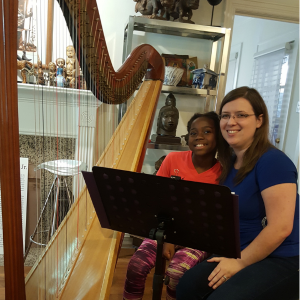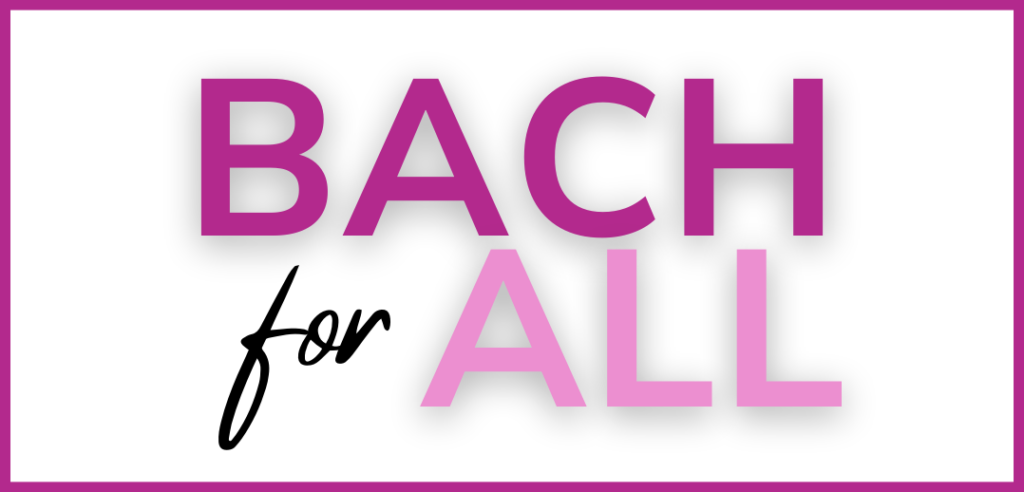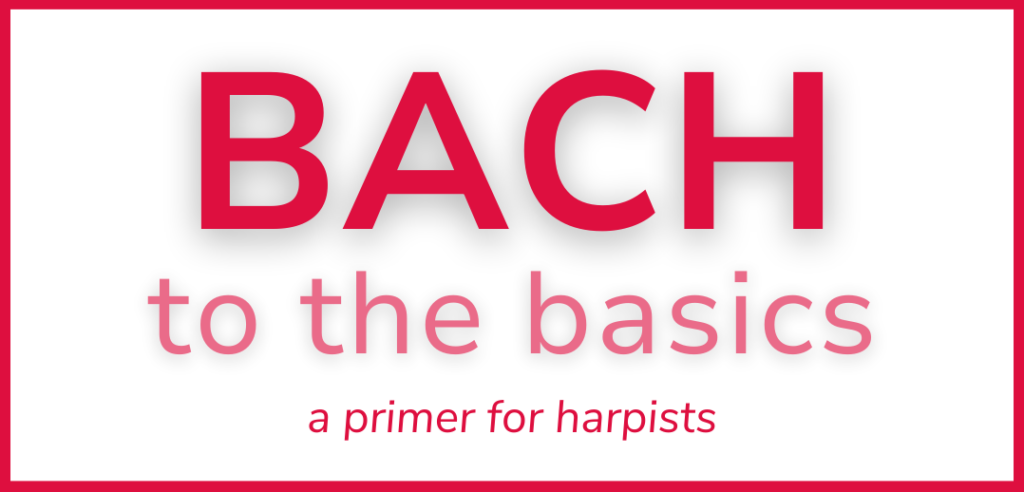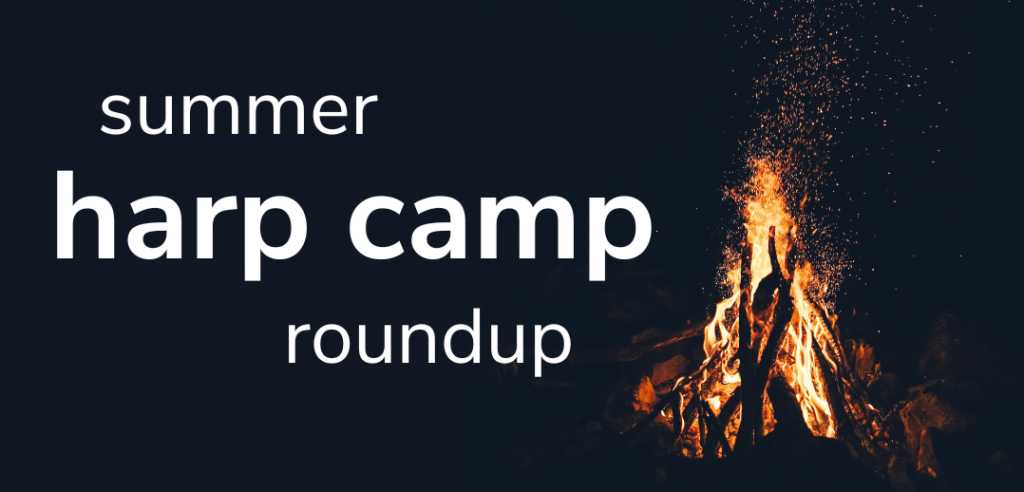If you teach harp lessons, it’s probably because you love to answer those questions about how to angle your fingers, what piece to learn for that recital, and how to take music and make it come to life on the strings. You likely teach because you want to nurture a love of music in others, not because you love keeping track of lesson payments or enforcing your cancellation policy. Wait, you don’t have a lesson cancellation policy? You also don’t have a payment collection system? It’s okay. You’ve come to the right place. We’ll show you some simple ways to organize your studio so you can spend more of your lesson time teaching and less time on administrative details.
Policies and procedures might seem unnecessarily corporate for a private harp teaching studio, but when issues arise with students (and issues will arise), you will have a clearly stated path to follow. Most students and teachers want to respect each other and are not trying to take advantage. However, expectations that may seem obvious to one may never occur to the other. Clearly defining them, along with accurate and accessible documentation, will ensure both sides know what is required of them and what will happen when those requirements are not met. Clear studio policies remove the pressure when a situation arises. Instead of deciding whether to charge Suzy Harpist for the no-call-no-show lesson, you can simply follow your written policies.
Getting started
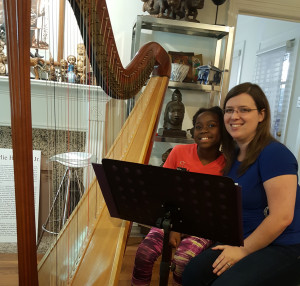
There is no one right way to create your studio policies, but I have found that having strict policies allows you to make exceptions when you feel it is appropriate, as opposed to having lax or undefined policies and then trying to uphold them with a difficult student or parent.
When a new student starts, go through your studio policies with the student and parent and get signatures from both. The student should keep their copy of the lesson policies in their music notebook for easy reference if there is a question. Are your policies old and out of date? Update them now and have all current students read and sign them at their next lesson. You don’t have to wait until the start of a new academic year or semester. Businesses update their terms of service all the time. You can do the same.
Attendance

Late arrivals and no-shows are a big headache for busy teachers, but implementing a thorough attendance policy will all but eliminate the headache. Providing 24 hours’ notice if the student needs to cancel a lesson is a standard requirement. For example, the student may find out they have a school activity or relatives coming to visit on their lesson day. When advance notice is given, most teachers will try to reschedule the lesson if possible, and some will give a credit towards the next month. Never give refunds, as this encourages canceling for financial reasons and sets a very poor precedent. If the student gives less than 24 hours’ notice, while no make-up or credit is technically owed, most teachers will give one if it is for a legitimate emergency, such as illness or car troubles, and the student makes a reasonable attempt to notify the teacher as soon as possible. Tiffany Schaefer, who teaches in Northwest Ohio and online, puts it this way, “My goal is only to stave off people canceling for no good reason.”
Design your attendance policy to discourage both tardiness and cancellations without notice. Never allow a reschedule for a no-call-no-show. If the student arrives late, they get however much lesson time is left in their slot. Do not go over their time to make up for their tardiness, even if you don’t have anything scheduled afterwards, as this will only encourage them to be tardy again in the future.
Your attendance policy should also state what happens if you have to cancel a lesson for a gig or illness. In these cases, most teachers will give a make-up lesson or credit. Philadelphia-based teacher Candace Lark takes a proactive approach so students can continue to make progress if she has to cancel. “Students are sent pre-recorded videos to watch and musicianship worksheets to do, use for practice, and turn in at the next lesson.” This is a great way to give value for the money paid and keep the student moving forward.
Billing
A well-designed billing schedule can actually help improve attendance. Consider this: have you ever had plans to go somewhere, maybe a concert or sporting event, but decided you were too busy, tired, or broke and canceled at the last minute? Sure, we all have. But how many times have you canceled at the last minute when you had purchased your tickets ahead of time? Money can be a highly motivating factor in following through on commitments. Your students face the same decisions of prioritizing harp lessons over other activities and even their feelings. The best way to discourage missed lessons is requiring payment in advance. This also eliminates the awkwardness of asking the student to pay for the lesson they missed. Train your students and parents from the beginning that your time is valuable, and once you block off time for that student’s lesson, it is time that you cannot schedule anything else, and therefore must be paid for. In a recent survey I conducted of nearly 200 harp teachers, 39 percent charged students at the lesson, 30 percent charged by the month paid in advance, and 24 percent charged by the semester or in sets of lessons to be used. A few teachers charged at the end of the month after the lessons were taught, which is risky. Personally, I charge a flat monthly rate which gives the student weekly 30 or 60 minute lessons. This means some months they may get five lessons, and some they may only get three, especially around the holidays. It generally evens out, and I find it helps both sides with budgeting and keeps people from canceling a lesson due to not having the funds to pay for that fifth week.
This brings us to the second half of billing: how to collect the money. There are many convenient ways to take payments beyond the traditional cash or check. With online payment processors like Stripe and Square, you can enter a student’s credit/debit card or even their bank account number once, and set up a recurring monthly charge as a subscription. This way, neither you or the student needs to remember to pay for the lessons. You just set up the schedule and forget about it. You can also store their info and charge it manually each month, which is great if you charge by the lesson rather than a flat monthly rate. Keep in mind credit card processors generally charge fee of about three percent per transaction. Other apps like PayPal, Venmo, and Cash App are popular choices among harp teachers as well. Remember, anytime a payment is made electronically, both parties receive an email confirmation, making it much easier to review payments later.
However you choose to bill for your lessons, you need a way to track those payments. Even if you only have one harp student, getting a system in place now will prepare you for when more students come your way. A payment tracking system helps ensure payments and lessons match, is invaluable at tax time, and is an excellent way for you to quickly assess how much you have made from lessons over a certain period of time, or how much from a certain student. Your system can be as simple as an Excel spreadsheet, or if you’re a Google Drive fan like me, a Google Sheets file. (Because Google Drive is free and stored online, you never have to worry about your computer crashing and losing all your records.) There are also excellent apps and software designed specifically for music teachers that can be used to track billing, schedule lessons, and more. I use Music Teacher’s Helper, which is free if you have five or fewer students. Another similar program is My Music Staff. Both of these software programs have a myriad of benefits for running a music studio. Barbara Fischer, who runs a private teaching studio in Florida, suggests using a free program called Wave Apps. She sends invoices, payment receipts, and uses it for bookkeeping. Her students are automatically billed at the beginning of the month, which she says not only helps ensure she’s paid, but also cuts down on time spent on paperwork during lessons.
The bottom line: keep track of lesson payments electronically, not mentally or scribbled on the back of an envelope on your desk. It’s easier than you think, so give it a try.
Scheduling
Everyone is busy, so it’s important to have a lesson schedule that both parties have access to, especially for those students who do not take weekly lessons. Music Teacher’s Helper and My Music Staff both allow you to enter lessons and have the system automatically send the parent or adult student an email confirming their lesson schedule. I use Google Calendar, as do many of the teachers I surveyed. When I create the lesson in my calendar, I simply add the email address of the student/parent, and it automatically sends them an email and calendar invite. I can set a lesson to be recurring and it will automatically schedule it out as far as I want. You can even set up a reminder to pop up before the lesson. I love using this, because if we have to reschedule a lesson, it sends the confirmation to the student. This prevents those mix-ups of either the teacher or the student forgetting a lesson or showing up the wrong day or time. It also helps with my online students that I teach over Zoom as it calculates time zone differences automatically. Calista Anne Koch, who has a very full studio of piano and harp students in Macon, Ga., schedules Fridays as her day off, which allows her to easily accept gigs or use that for make-up lessons as needed. If a student cannot make it Friday, they will simply have to wait until the following week for their next lesson. Remember, no matter how you decide on a lesson time, whether verbally in a lesson, over the phone, or through a text or Facebook message, it should always be confirmed electronically somehow in a way that can be easily referenced, such as an email or calendar notice.
Communication
Every harp teacher knows that students will have questions that arise outside of their weekly lesson time. However, we don’t want to become a 24-hour hotline for students to call with every little question. We want to encourage our students to let us know when they are having trouble with lesson material, might need to cancel a lesson, broke a string and need help changing it, or have a performance opportunity and need some advice right away. Let your students know ahead of time that they should contact you in these instances, not just wait for the next lesson. It is helpful to steer students to your preferred method of communication, both for last minute cancellations and all other communication. For example, you may prefer a text message if they get a flat tire on the way to the lesson, since you can glance at it while in a lesson with another student, whereas you might not answer a phone call or read an email until later. It’s easier to set expectations ahead of time than to awkwardly ask a student to please not call during your lessons, or please don’t wait a week to let you know that their harp fell over.
Beyond the lesson
Lesson time is a precious resource, and no matter how long the lesson, it always seems to go by too fast. Consider ways you can continue to motivate your students and help them grow during the six days a week you don’t see them. The traditional student recital is always a great motivating factor, and teachers can structure them in a way that works for their studio. Bambi Fischer says her students of all ages are expected to participate. “If they do not feel ready, they are asked to attend to support their friends and participate in an activity, such as greet the guests individually before the program.” Calista Anne Koch offers a harp ensemble for her students, which opens and closes her recitals. The recital is a requirement for her students unless they have a reasonable excuse to miss it, in which case they are still required to perform their prepared works for an audience that is more than their immediate family within two weeks of the scheduled recital. Candace Lark has an adult-student-only coffee hour. They play for each other and enjoy coffee, wine, and refreshments. Tiffany Schaefer teaches mostly online, so she offers fall and spring recitals over video chat. Christine Vivona, who teaches in Tucson, Ariz., offers both recitals and an annual summer harp camp. If students do not want to perform solos, she sets up ensemble opportunities for them.
Technology can also be a wonderful resource for adding value beyond the lesson. There are great apps to help students with basic note reading skills, such as Music Theory Helper and Music Tutor. I create videos for my students to use as practice tracks. Because I have created my own beginning harp curriculum and most students are learning the same songs at the beginning of their studies, I can create a video once and share it with multiple students. I upload the videos to my YouTube channel and set them as unlisted so the public does not see them, then email the link to students. I also create special arrangements for them using MuseScore (free music notation software). Once an arrangement is created for one student, I can use it with other students, make a more advanced or simpler version, or adapt it to be an ensemble piece. I can put the files in my private MuseScore group, and my students can use the app on their phones to play along with the music, even slowing down the tempo and adding in a metronome. Christine Vivona uses her iPad to show students how to listen to several different recordings of repertoire or styles of music as well as help students with rhythm by using different metronome apps. For jazz students, she uses Jamey Aebersold recordings of Music Minus One to help them experience playing in a jazz group. She also uses the iReal Pro app on her phone to show them how to play jazz tunes in the Real Book. There are many amazing music apps out there that engage students and expand the lesson experience, so choose a few and try them out.
Instrument loans and rentals
One of the biggest obstacles to a new student starting lessons is acquiring a harp. Most people are not in a place financially to purchase an expensive harp immediately, especially not knowing if they will stick with the instrument. If you are able to purchase lever harps to use as student rentals, you will have a much easier time starting new students. Watch for used harp listings and don’t be afraid to get one with some dings and scratches—as a rental it’s bound to get more of those anyway. If you can’t get rental harps yourself, find someone in your area who has harps for rent and connect with them ahead of time to learn their rental policies and rates so when a new potential student asks about lessons, you can help them get started right away. In Houston, the local chapter of the International Society of Folk Harpers and Craftsmen, the Gulf Coast Harpers, has purchased a number of lever harps over the years and rents them to students of their members.
If you do decide to rent a harp to your student, you will need a detailed rental contract. Mine is five pages long and includes not just monthly rent, due dates, and late payment rates, but also expectations like harp care—how often the student should be tuning the harp, the acceptable temperature range for the harp, and policies on insurance and string replacement. Calista Anne Koch requires that students who rent her harps take weekly lessons, bring the harp to her whenever they have a problem (such as a broken string), and notify her if they are using the harp for any performances. She provides insurance on the instruments and will replace base wires and any strings that break from normal wear and tear. Remember that you will need to provide your insurance company with information about your renter for the harp to be covered. If you decide to loan or rent other equipment to a student (such as a music stand, bench, or dolly), be sure it is clearly documented and return dates are discussed. Music Teacher’s Helper has a nice feature to track equipment loans.
We all play harp because we have a deep love for the instrument and the music it creates. But taking some time to put systems and procedures in place will go a long way to making the harp lesson experience positive for you, your students, and their parents. •
A cure for the chronically unprepared student
If there is one thing that can really sabotage lesson time, it’s the student who doesn’t practice and constantly shows up for lessons unprepared. Calista Anne Koch has found an effective method for dealing with these students. She institutes a probationary period for students who are not progressing.
“When a student enters into probation, it is most often due to lack of practice. I try to encourage them by providing a practice log, asking the hard questions of both them and their parents, and reminding them that they signed the contract saying that they agreed to practice. If I can open the dialog as to why they aren’t getting enough practice time, I can usually help them change their habits. I ask what their practice schedule is, and if I can see a problem with when or how often they are practicing, I put them on a practice log and require the parents to sign off on it. If, after a six-month period of being on probation, they have not improved, I have the option to dismiss them from my studio. On the flip side, if someone changes their habits and finds the motivation to start progressing again, I usually hone in on what worked for them. Each student is different, and sometimes it is something as simple as them needing a more immediate goal than our recitals to help get them out of the funk they found themselves in. In all honesty, I remind myself often that my job is to work with those that are willing to do this for themselves. I don’t need to hold on to students that don’t want to do this. I have said on more than one occasion that I am a very expensive babysitter if all the parents are going to do is pay me to keep their kids for an allotted time each week and watch them practice!”
Building a studio
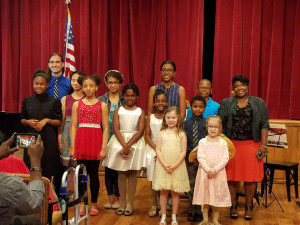
When it comes to finding those new student leads, word of mouth referrals from happy students and music colleagues are highly effective. However, there are plenty of more creative ideas our experts suggest for finding new students, including a great one from Candace Lark (pictured here at her studio recital, far right), “Bring a Buddy to a Lesson” parties, which she hosts twice a year.
- hold recitals at public venues
- advertise performances and student recitals to the public
- invite potential students to recitals
- hold hands-on harp events at local museums
- do youth orchestra events
- hold private harp tastings
- connect with church and homeschool communities
- create a harp ensemble that regularly performs in the community
- have students perform in local ensembles
- have business cards for teaching at gigs
- et kids try the harp at your gigs
- have a professional website and social media presence
- give lessons at a music store
- offer harp workshops to local schools
- create a YouTube channel that includes beginning tutorials that show your teaching style
- use Facebook Marketing and Google Adwords
- host “Bring a Buddy to a Lesson” parties







